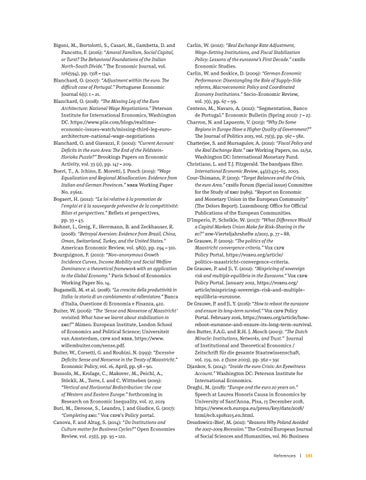Bigoni, M., Bortolotti, S., Casari, M., Gambetta, D. and Pancotto, F. (2016): “Amoral Familism, Social Capital, or Turst? The Behavioral Foundations of the Italian North-South Divide.” The Economic Journal, vol. 126(594), pp. 1318 – 1341. Blanchard, O. (2007): “Adjustment within the euro. The difficult case of Portugal.” Portuguese Economic Journal 6(1): 1 – 21. Blanchard, O. (2018): “The Missing Leg of the Euro Architecture: National Wage Negotiations.” Peterson Institute for International Economics, Washington DC. https://www.piie.com/blogs/realtimeeconomic-issues-watch/missing-third-leg-euroarchitecture-national-wage-negotiations Blanchard, O. and Giavazzi, F. (2002): “Current Account Deficits in the euro Area: The End of the FeldsteinHorioka Puzzle?” Brookings Papers on Economic Activity, vol. 33 (2), pp. 147 – 209. Boeri, T., A. Ichino, E. Moretti, J. Posch (2019): “Wage Equalization and Regional Misallocation: Evidence from Italian and German Provinces.” NBER Working Paper No. 25612. Bogaert, H. (2012): “La loi relative à la promotion de l’emploi et à la sauvegarde préventive de la compétitivité: Bilan et perspectives.” Reflets et perspectives, pp. 33 – 45. Bohnet, I., Greig, F., Herrmann, B. and Zeckhauser, R. (2008): “Betrayal Aversion: Evidence from Brazil, China, Oman, Switzerland, Turkey, and the United States.” American Economic Review, vol. 98(1), pp. 294 – 310. Bourguignon, F. (2010): “Non-anonymous Growth Incidence Curves, Income Mobility and Social Welfare Dominance: a theoretical framework with an application to the Global Economy.” Paris School of Economics Working Paper No. 14. Bugamelli, M. et al. (2018): “La crescita della produttività in Italia: la storia di un cambiamento al rallentatore.” Banca d’Italia, Questione di Economia e Finanza, 422. Buiter, W. (2006): “The ‘Sense and Nonsense of Maastricht’ revisited: What have we learnt about stabilization in EMU?” Mimeo. European Institute, London School of Economics and Political Science; Universiteit van Amsterdam, CEPR and NBER, https://www. willembuiter.com/sense.pdf. Buiter, W., Corsetti, G. and Roubini, N. (1993): “Excessive Deficits: Sense and Nonsense in the Treaty of Maastricht.” Economic Policy, vol. 16, April, pp. 58 – 90. Bussolo, M., Krolage, C., Makovec, M., Peichl, A., Stöckli, M., Torre, I. and C. Wittneben (2019): “Vertical and Horizontal Redistribution: the case of Western and Eastern Europe.” forthcoming in Research on Economic Inequality, vol. 27, 2019 Buti, M., Deroose, S., Leandro, J. and Giudice, G. (2017): “Completing EMU.” Vox CEPR’s Policy portal. Canova, F. and Altug, S. (2014): “Do Institutions and Culture matter for Business Cycles?” Open Economies Review, vol. 25(1), pp. 93 – 122.
Carlin, W. (2012): “Real Exchange Rate Adjustment, Wage-Setting Institutions, and Fiscal Stabilization Policy: Lessons of the eurozone’s First Decade.” CESifo Economic Studies. Carlin, W. and Soskice, D. (2009): “German Economic Performance: Disentangling the Role of Supply-Side reforms, Macroeconomic Policy and Coordinated Economy Institutions.” Socio-Economic Review, vol. 7(1), pp. 67 – 99. Centeno, M., Navaro, A. (2012): “Segmentation, Banco de Portugal.” Economic Bulletin (Spring 2012): 7 – 27. Charron, N. and Lapuente, V. (2013): “Why Do Some Regions in Europe Have a Higher Quality of Government?” The Journal of Politics 2013, vol. 75(3), pp. 567 – 582. Chatterjee, S. and Mursagulov, A. (2012): “Fiscal Policy and the Real Exchange Rate.” IMF Working Papers, no. 12/52, Washington DC: International Monetary Fund. Christiano, L. and T.J. Fitzgerald. The bandpass filter. International Economic Review, 44(2):435-65, 2003. Cour-Thimann, P. (2013): “Target Balances and the Crisis, the euro Area.” CESifo Forum (Special issue) Committee for the Study of EMU (1989). “Report on Economic and Monetary Union in the European Community” (The Delors Report). Luxembourg: Office for Official Publications of the European Communities. D’Imperio, P., Schelkle, W. (2017): “What Difference Would a Capital Markets Union Make for Risk-Sharing in the EU?” DIW-Vierteljahrshefte 2/2017, p. 77 – 88. De Grauwe, P. (2009): “The politics of the Maastricht convergence criteria.” Vox CEPR Policy Portal, https://voxeu.org/article/ politics-maastricht-convergence-criteria. De Grauwe, P. and Ji, Y. (2012): “Mispricing of sovereign risk and multiple equilibria in the Eurozone.“ Vox CEPR Policy Portal. January 2012, https://voxeu.org/ article/mispricing-sovereign-risk-and-multipleequilibria-eurozone. De Grauwe, P. and Ji, Y. (2016): “How to reboot the eurozone and ensure its long-term survival.” Vox CEPR Policy Portal. February 2016, https://voxeu.org/article/howreboot-eurozone-and-ensure-its-long-term-survival. den Butter, F.A.G. and R.H. J. Mosch (2003): “The Dutch Miracle: Institutions, Networks, and Trust.” Journal of Institutional and Theoretical Economics / Zeitschrift für die gesamte Staatswissenschaft, vol. 159, no. 2 (June 2003), pp. 362 – 391 Djankov, S. (2014): “Inside the euro Crisis: An Eyewitness Account.” Washington DC: Peterson Institute for International Economics. Draghi, M. (2018): “Europe and the euro 20 years on.” Speech at Laurea Honoris Causa in Economics by University of Sant’Anna, Pisa, 15 December 2018, https://www.ecb.europa.eu/press/key/date/2018/ html/ecb.sp181215.en.html. Drozdowicz-Bieć, M. (2011): “Reasons Why Poland Avoided the 2007-2009 Recession.” The Central European Journal of Social Sciences and Humanities, vol. 86: Business
References | 141

